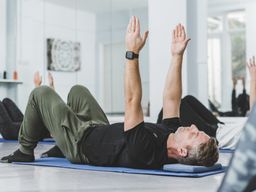Pilates for bone health and osteoporosis
It is estimated that 3 million people in the UK suffer from osteoporosis – 1 in 3 women and 1 in 12 men. It is known as the silent epidemic because many people are unaware that they have it until they suffer a fracture.
Low bone density most affects the spongy honeycomb-like bone on the inside of the bone. Some of the struts within the structure of the bone become thin or break, leaving the bone porous and more fragile with a greater chance of fracture.
If your bone density is more than 25% lower compared to the young adult mean, then you are considered to have osteoporosis.
Even without osteoporosis, building bone density is important. This is because bone density decreases as part of the natural ageing process. Once we reach middle age (this is actually 35+!) the rate of bone building reduces and a reduction in bone density will start to occur. Bone loss becomes particularly rapid for women in the first few years following the menopause – as much as 20% of bone density can be lost in the 5-7 years following menopause.
Men and women lose bone at the same rate from around 65/70 years. Building up your ‘bone bank’ during the years of good bone growth is really important to help protect against the effects of reducing bone density once we pass middle age
How can Pilates help?
Getting a diagnosis of osteoporosis can make exercise and even simple daily movements seem daunting. The Pilates for Bone Health sessions are designed for people with osteoporosis and the movements are safe. These sessions will teach you correct movement patterns, help to strengthen your spine and the muscles around your joints and give you the confidence to move and stay active.
In fact, these classes are not just for people with a diagnosis of osteoporosis. As mentioned, reduced bone density comes to all of us as we age and the classes are good for all those who wish to build strength, improve posture and balance.
The classes include a combination of weight-bearing and muscle strengthening exercises which are recommended to promote bone density.
What does this mean?
Each class will be balanced, targeting all the main joints and working through every plane of movement to improve overall muscle strength and flexibility and learn to find and maintain neutral spinal alignment. Work will be done to strengthen muscles around vulnerable bones, particularly the spine, hips, wrists and ankles.
The lesson plans will follow the strong, steady, straight guidelines from the Royal Osteoporosis Society, focusing on weight-bearing/impact training (strong), muscle strengthening for balance and falls prevention (steady) and back muscle strength to improve posture and reduce pain (straight).
Variety is important to target all skeletal sites and resistance will gradually be increased to promote maximum bone strength. We will also include breathing practice to open and strengthen the front of the chest.
The classes will support your long term management of osteoporosis, starting with mastering some beneficial exercises to help with posture and strengthening of the spinal muscles. The sessions will be particularly beneficial when part of a wider plan to manage overall health, fitness and bone density, for example by engaging in low/moderate impact exercise three time per week.
How do I know if these classes are suitable for me?
If you wish to come along to the class you will need to complete a short enrolment form where you will provide relevant medical information including details of your osteoporosis e.g T-scan results and any history of fractures. This means that I can design an exercise programme that is suitable for you.
The exercises are fairly gentle and suitable for most people. You will need to be able to get up and down from the floor as several of the exercises are done on the mat. However, if you struggle with this but are still interested to try Pilates, please contact me to look at options.
You should wear loose or stretchy comfortable clothes that you can move in. I will provide everything else you need but if you have your own mat you can bring this. And perhaps a small towel for extra head support if needed.
If you would to find out more or book in, please contact me or book online




